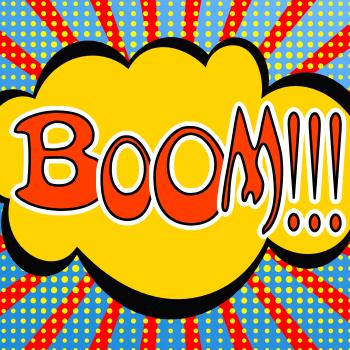Buzz! Whiz! Bang! Using Comic Books to Teach Onomatopoeia

- Preview |
- Standards |
- Resources & Preparation |
- Instructional Plan |
- Related Resources |
- Comments
Overview
Bam! Beep! Zoom! Students are sure to delight in the study of onomatopoetic words through the use of comic strips. In this lesson, students begin with an introduction to onomatopoeia, which describes words that imitate the natural sound associated with an action or object. As a class, students view several comic strips and are guided in identifying examples of onomatopoeia. The group then discusses the purpose of onomatopoeia and its effect in a story before students work individually to find examples of onomatopoeia in other comics. Finally, students work individually or in pairs to create their own comic books that include onomatopoeic language. After presenting their comics to the class, students discuss the use of onomatopoeia and its effectiveness in each comic strip.
From Theory to Practice
Comic books have had a motivating power in literacy development for children, especially young boys, since their introduction in the 1930s. This nontraditional type of literature—often dismissed by educators as superficial and shallow—is highly visual, contains complex literary elements, and lends itself to critical examination of moral, ethical, and social issues.
Common Core Standards
This resource has been aligned to the Common Core State Standards for states in which they have been adopted. If a state does not appear in the drop-down, CCSS alignments are forthcoming.
State Standards
This lesson has been aligned to standards in the following states. If a state does not appear in the drop-down, standard alignments are not currently available for that state.
NCTE/IRA National Standards for the English Language Arts
- 2. Students read a wide range of literature from many periods in many genres to build an understanding of the many dimensions (e.g., philosophical, ethical, aesthetic) of human experience.
- 3. Students apply a wide range of strategies to comprehend, interpret, evaluate, and appreciate texts. They draw on their prior experience, their interactions with other readers and writers, their knowledge of word meaning and of other texts, their word identification strategies, and their understanding of textual features (e.g., sound-letter correspondence, sentence structure, context, graphics).
- 4. Students adjust their use of spoken, written, and visual language (e.g., conventions, style, vocabulary) to communicate effectively with a variety of audiences and for different purposes.
- 5. Students employ a wide range of strategies as they write and use different writing process elements appropriately to communicate with different audiences for a variety of purposes.
- 6. Students apply knowledge of language structure, language conventions (e.g., spelling and punctuation), media techniques, figurative language, and genre to create, critique, and discuss print and nonprint texts.
- 12. Students use spoken, written, and visual language to accomplish their own purposes (e.g., for learning, enjoyment, persuasion, and the exchange of information).
Materials and Technology
- Copies of comic books or strips
- LCD or overhead projector
- Chart paper and markers
- Computers with Internet access and printing capability
Printouts
Websites
Preparation
| 1. | This lesson assumes that students have previous experience with the structure of comic books and comic strips. If students need to build their background knowledge about comics, consider completing the lessons Comics in the Classroom as an Introduction to Genre Study and Comics in the Classroom as an Introduction to Narrative Structure prior to teaching this lesson. Combining these lessons creates a mini-unit of literary investigations using comic books or strips. |
| 2. | Choose some sample comic strips to share with the students that contain multiple examples of onomatopoeia. You will want one or two to use as examples with the class and then a variety of examples for students to explore on their own. Online resources for comic strips include Archie Comics, Garfield and Friends Official Site and The Official Peanuts Website. |
| 3. | Arrange to use an LCD projector to share the comic strips with the class or print them and make transparencies. Print copies of the comics that students will explore independently (see Session 1, Step 6). |
| 4. | Make sure that students have permission to use the Internet, following your school policy. If you need to, reserve a session in your school's computer lab (see Session 3). |
| 5. | Familiarize yourself with the Comic Creator and bookmark it on your classroom or lab computers. This online tool allows students to create a comic strip using a set of characters and props. Students have the ability to write their own captions. |
| 6. | Make copies of the Comic Strip Planning Sheet and the Comic Strip Rubric for each student. Students will use the planning sheet to draft and revise their work before actually creating and printing their comic panels on the Comic Creator. Introduction of the Comic Strip Planning Sheet provides an excellent mini-lesson for reviewing the literary elements of character, setting, and plot. |
Student Objectives
Students will
- Increase their knowledge of literary terms and how they are used in everyday writing by defining onomatopoeia using comic strips or books
- Demonstrate comprehension of onomatopoeia by locating onomatopoetic words in comic books
- Explore the effect onomatopoeia has in comic books and other narratives through a class discussion
- Apply their knowledge of onomatopoeia and the structure and narrative form of comics to create their own comic strips containing onomatopoetic words
Session 1
| 1. | Show the sample comics you have chosen to the class using the transparencies or LCD projector. Tell students that you will read the comics aloud and that as you do so, they should listen for words that imitate the natural sound associated with an action or an object, for example bang or slam. |
| 2. | When you are finished, ask students to tell you what words like this they heard. Highlight these words by writing them on chart paper or using a marker on the transparency. |
| 3. | Explain that words like this are examples of onomatopoeia. Write onomatopoeia on a piece of chart paper or the board so that students can see how it is spelled. |
| 4. | Reread the comic with the whole class, instructing students to read the onomatopoetic words using sound effects and emphasis. For example, have them read a word like boom loudly, with emphasis placed on the rounded vowel sounds created by the double /oo/. |
| 5. | Have students write the word onomatopoeia in their personal dictionaries with this basic definition: words that make the sound of the action or object. If any of the words you located in the sample comics are unfamiliar to students, they should add these as well. The definition of onomatopoeia could also head a word wall made from the chart paper list. This word wall should be posted where students can easily see it while they work on their own comic strips later in the lesson. |
| 6. | Talk about why writers of comic strips would use onomatopoeia and what function these words serve in a narrative. Questions for discussion include:
|
| 7. | Pass out copies of the sample comic strips you have printed for students to use in locating onomatopoeias. Allow time for students to find the onomatopoeias and to share the humor and story of the comics with each other. |
| 8. | Close the lesson by discussing new or unusual onomatopoeias students found in their comics; add these to the class word wall or have students add them to their personal dictionaries. |
Session 2
| 1. | Review the definition of onomatopoeia and the list of onomatopoetic words from the previous lesson, using the word wall if you have posted one. Ask students to think of any onomatopoetic words that are not included in the list; add any that they are able to come up with. |
| 2. | Ask students to remember some of the ways they saw onomatopoeias being used in the comics they looked at in the previous session. What are some of the ways they might use these words in creating a comic strip of their own? |
| 3. | Give each student a copy of the Comic Strip Planning Sheet. Explain that they are to use this handout to help them brainstorm a six-panel comic strip. Talk about how, like a book, a comic strip tells a story and has a plot, characters, and action. For each panel, they should list the landscape and props they will use (chosen from the list on the sheet), the characters present in that panel, the actions that take place, the caption or words the characters speak, and any onomatopoeias they plan to use. |
| 4. | Give students the rest of this session to work on their planning sheets. Allow students to work individually or in pairs to create their comic strips. Encourage discussion and sharing of ideas of how to use onomatopoeia. Circulate among the students to monitor progress, provide support in writing, and to assess their understanding of onomatopoeia. Students should save their planning sheets to use in Session 3. |
Session 3
Note: Students will use computers for this session, so if necessary, you should conduct all or part of it in the computer lab.
| 1. | Demonstrate the use of the Comic Creator. Explain that students will begin their own writing project to create a six-panel comic strip with dialogue that includes onomatopoeias. Students should print their work when they complete it. |
| 2. | Distribute the Comic Strip Rubric and review it. Tell students that they should use the rubric check their comic strips when they have finished their work. Explain that you will use this same rubric when you evaluate their comic strips. |
| 3. | Ask students to use the Comic Strip Planning Sheets they filled out in Session 2 to complete a comic using the Comic Creator. Circulate among the students to monitor progress and provide support as they work. Collect the printed versions of the comics when students have completed them. |
Session 4
Share students' comics with the entire class by projecting them on an overhead or displaying them on a board. Discuss students' use of onomatopoeia. Questions for discussion include:
- How does onomatopoeia work in this comic strip? What does it add to the story?
- How would the comic strip be different without using onomatopoeia?
- Can you think of any additional ways this student could have used onomatopoeia?
Extensions
- To help develop reading fluency, assign roles and make copies of the comics with the respective parts of the dialogue highlighted. Have students practice reading the different parts out loud. Present the comic panels on an overhead projector while students read the parts dramatically for the whole class.
- Organize a comic book convention for students to read and critique fellow students' comics.
Student Assessment / Reflections
- Informally assess students' understanding of onomatopoeia, their ability to locate onomatopoetic words, and their grasp of how and why onomatopoeia is used during the discussion in Session 1 and while you circulate as students are writing their own comics.
- Use the Comic Strip Rubric to assess understanding and use of onomatopoeia in the student-created comic strip panels.
- Assess students' abilities to locate onomatopoetic words by giving them another comic strip or book (or some other form of text) and asking them to identify and record the onomatopoeias they find.

Tessa
Edinburgh, Scotland
Tessa
Edinburgh, Scotland
Tessa
Edinburgh, Scotland
Add new comment